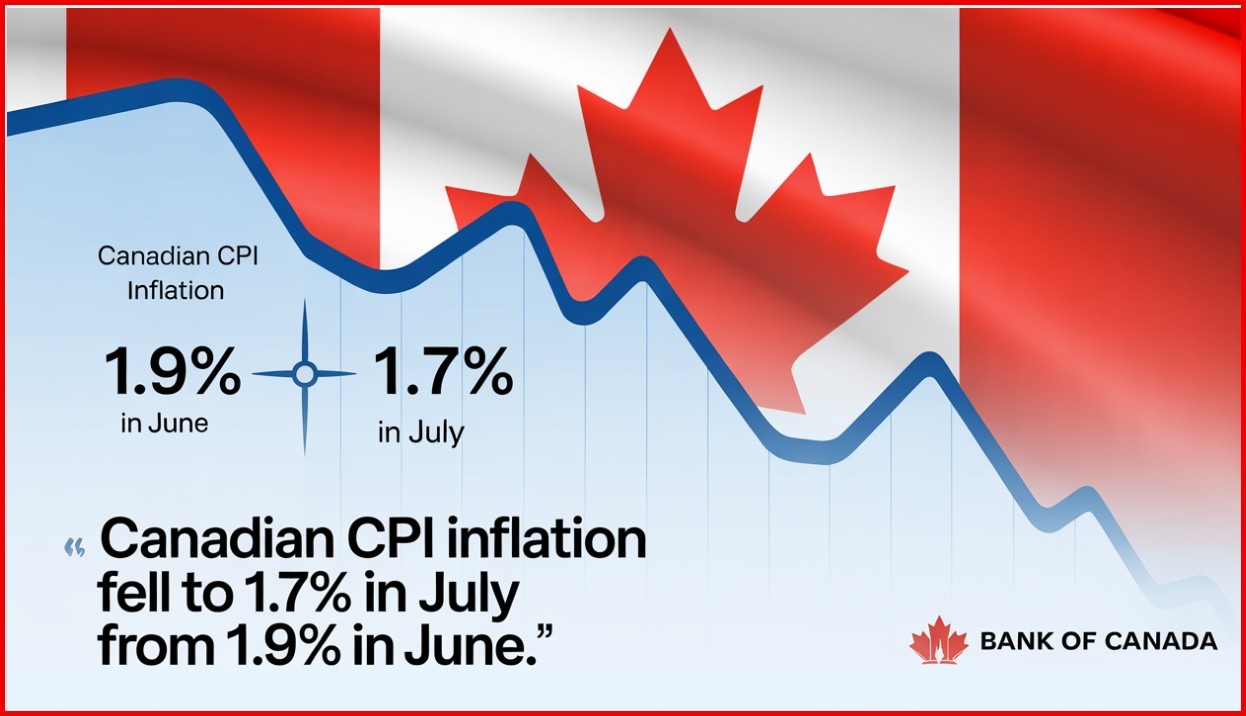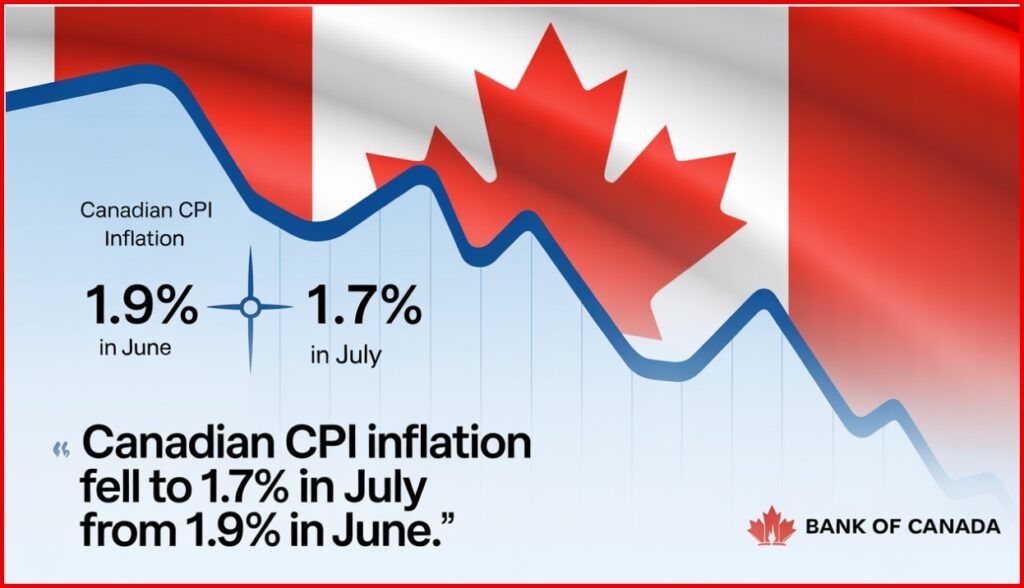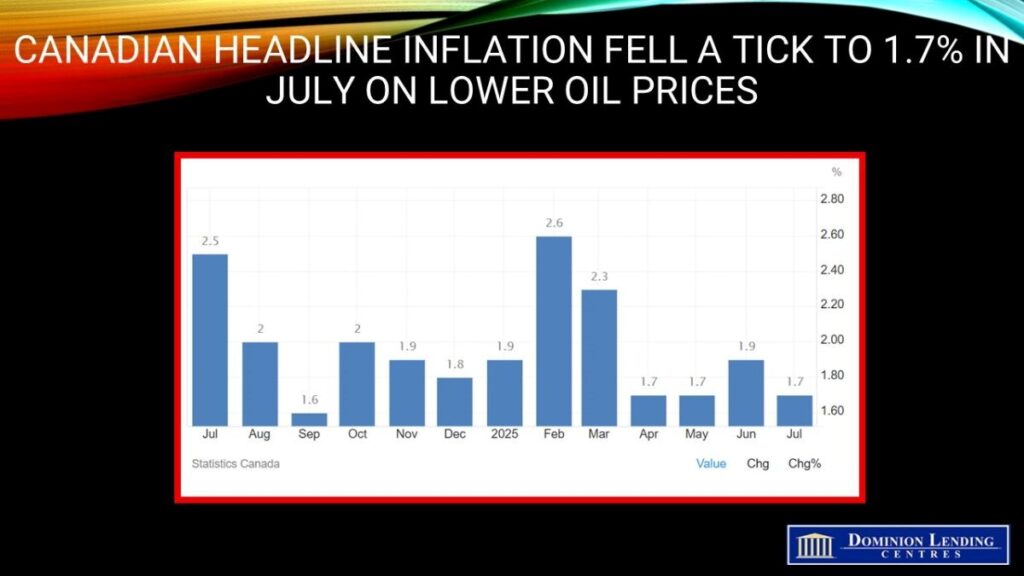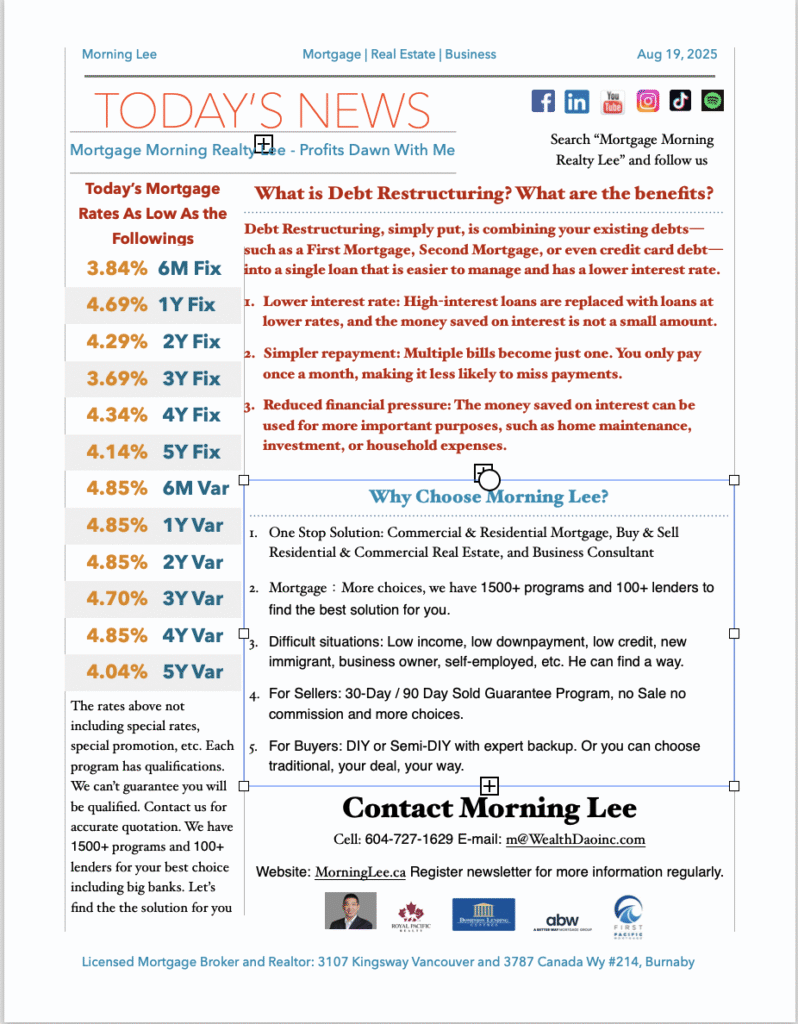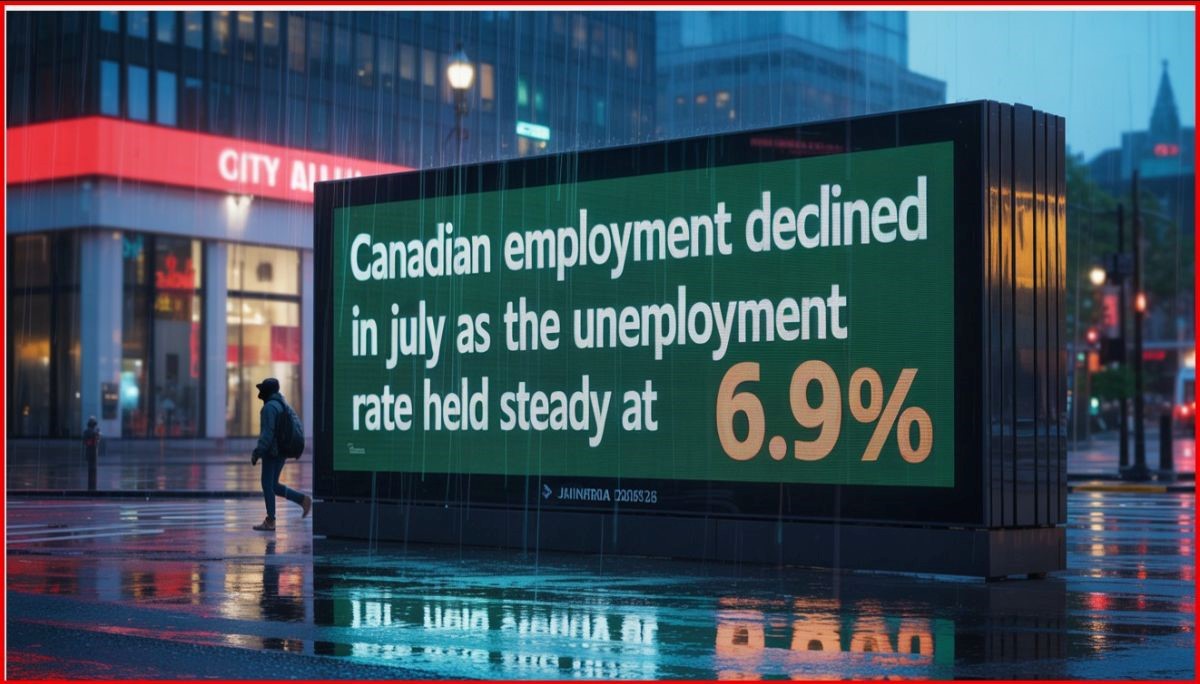September is a polarizing month – back to school and the end of summer but also the beginning of fall and pumpkin spice everything season. And honestly, this month’s newsletter articles are polarizing too. When looking at the fall housing market, experts are polarized in their predictions on market conditions. And when it comes to a financial audit, deciding what spending mistakes you’ve been making and how to make changes might be polarizing too!
So, enjoy the articles, and here’s hoping we have more sunny days before the month races to an end.
The Fall Forecast: Cooling Temps, Hot Market Moves
Fall 2025’s real estate market theme is perhaps best summed up as “wait and see”. The spring market was flat. Experts have mixed reports about the national average home prices for the remainder of the year. Most (CREA, CMHC, etc.) predict a drop between 1.7-3.2%, but Royal LePage is an outlier still echoing their early year prediction of 3.5-5% price increase.

There are some notable regional differences. In Alberta, Saskatchewan and Quebec, they could see sales at historically high levels and faster price growth. Big Ontario and BC market declines are overshadowing these numbers and lowering the national average.
Biggest factors in the home-buying market this fall
- Affordability: the high cost of living – especially buying a home – is more than many new buyers can afford. The average MLS price for a home currently nearly $680,000. Homebuyers need big down payments, longer term loans, and will pay much more interest over the lifetime of the mortgage – none of which are appealing. Many are saying no thanks.
- US trade disputes: 49% of prospective buyers have chosen to hold off on a purchase because of impending tariffs and their ripple effects. A resolution could lead to a quick market turnaround, but there’s no way to know what’s coming.
- Economic cooling: unemployment, slower population growth and a mild recession are all contributing to a slower fall housing market.
- Rental market: Condo completions are surging, flooding the market and finally cooling off demand. People have more rental options, with potentially lower rates, which negates the need to buy. Also of note is slower household formation, meaning fewer people are looking to move out of their parents’ homes and in with their new spouse or partner.
- New builds: Builders are seeing reduced demand and cutting back production accordingly. Current tariffs are increasing the material costs for new homes, another reason to delay starts. The CMHC is predicting only 226,600 home starts for 2025.
What about rates?
The Bank of Canada has paused interest rate drops since April, which has given potential mortgagees pause. There is still one more rate cut predicted this year which could turn the market around.
Initially, the CMHC was estimating 5-year fixed rates between 5.3-5.7% this year, but with that now out the window and lower rates currently available, the remainder of 2025 is the ideal time to get a mortgage for anyone who doesn’t already have one or imminently needs to renew. With a potential Bank of Canada rate cut looming, variable rates are also still attractive.
Is anyone opting to buy this fall?
Yes! Resale homes are gaining market share, with somewhere between 464,600 and 524,600 homes expected to change hands in 2025.
There are also two main buyer demographics:
- Millennials: With remote work declining, they need to buy homes closer to their jobs. Urban market resale homes will likely be their prime targets.
- Renewals: Those needing to renew their mortgages will consider their actual needs vs their existing home. Downsizing to save costs or upsizing to accommodate changing family needs are big factors. This is the ideal time to make a move without (mortgage) penalties.
What does all this mean?
We’ll all be waiting to see what happens. If you want to buy, there is more supply and the lowest rates we’ve seen in a while. If you want to sell, the resale market is your friend. Either way, I can help you work out the mortgage you’re going to need.
Adulting 101: Back-to-School Budgeting for Real Life
If it’s time for you to stop rearranging the deck chairs on the Titanic and start a purposeful financial audit – I’ve got you. Here we’re going beyond gathering statements, categorizing expenses and hoping to reduce spending. I’m going to give you the motivation to take action by looking at the WHY, WHAT, and HOW to get you into a different mindset with better results.

Why do a financial audit?
Auditing your finances is all about identifying how you’re spending your hard-earned cash. An audit works because it uncovers money pits you didn’t realize you’d fallen in, and gets you thinking about your financial goals. An audit will:
- Identify overspending patterns
- Calculate the true cost of ownership of items like a vehicle, your home, etc.
- Catch any fraud or transaction errors
- Pinpoint areas of spending to limit or reduce
- Highlight items you’re automatically paying for but not using
- Reallocate resources to higher priority items
- Help you meet life goals that require money (like a degree, a home or the trip of a lifetime)
So, if that sounds good, it’s time to get started. What you need to ask yourself during an audit:
To get your finances on track, first get to the root of your current spending. Here’s what to ask yourself:
- What are your goals for your earnings?
- What are your life goals?
- How much do you *think* you spend vs how much do you *actually* spend on things like entertainment, shopping, and other non-essentials?
Sometimes the biggest shock of a financial audit is how different your expectations are from your reality. So let’s now figure out what you should still spend money on, and what you shouldn’t. Here’s what to ask yourself:
- What spends bring you the most joy?
- What items could you skip or cut back without much negative impact?
- What spends contribute towards your life and financial goals?
You probably can’t afford (and don’t need) everything you feel like spending money on. You’ll have to make choices. A financial audit shows your financial pitfalls and puts those spending traps into perspective against your goals.
How to stay committed:
You found a reason to conduct this financial audit, figured out what spending to cut back on, and now it’s time to action your findings. How? Step one is to set both short and mid term goals in specific time frames and reward yourself when you achieve them. SMART goals never looked better.
If it works for you, find a free app to track your card taps, and set alerts so you know immediately when you’ve gone off track. If that’s not for you, here are more strategies on how to stay committed and accountable:
- Make a visual of your goal – print a picture, make a vision board, etc.
- Share your goals with someone that will help keep you accountable
- Treat it like the first year of dating – celebrate small milestones, talk about it with your friends, and ignore the sacrifices you’re making
- Distract yourself when you’re tempted to spend – go for a walk, do a craft, get outside, make a puzzle, whatever gets you away from temptation
- Make it a game, like a week-long no-buy or going one month without eating out. You can give it a fun name like ‘dine-in December’ or ‘the week without’
- Make a direct correlation between the amount something costs and the number of hours you have to work to get it. If you earn $40/hour, and something costs $200, you’ll have to work for 5 extra hours to earn it. Is that worth while?
For the times when you’re getting derailed and need some reprieve, here’s how to make that work:
- Try to use up gift cards, store credit or points (like Optimum or Aeroplan) on the out-of-budget items
- Need more cash? Use marketplace or Kijiji to sell things you don’t need or want
Auditing your spending isn’t about guilt—it’s about gaining clarity. With a clear picture of where your money typically goes, and what you’d really like to use it for, you can make smarter choices and set yourself up for future financial success.
Economic Insights from Dr. Sherry Cooper
The Bank of Canada has maintained its target for the overnight rate at 2.75% since March 12. This was the seventh consecutive cut since mid-2024, when the Bank began lowering the rate from 5.0% in response to a potential economic slowdown caused by increased trade tensions with the United States.
Very early in the new Trump administration, tensions emerged as the president threatened to place sizable tariffs on Canadian imports not covered by the Canada-US-Mexico free trade agreement (CUSMA). President Trump has increased tariffs on non-CUSMA-compliant goods from Canada from 25% to 35%, effective August 1.
It is currently estimated that roughly 80% of Canadian exports are CUSMA-compliant, headed for 89% in the coming months. This has kept the lid on the overall tariff burden. In June, 77% of Mexican imports met the trade pact’s country of origin criteria, up from 42% May. Fitch rating service estimates the compliance proportion will rise to 83%.
In addition, there is a 50% tariff for all countries’ exports of steel and aluminum into the US. There is a 10% tariff on non-CUSMA-compliant potash, oil, and gas products. And a 50% tariff on some copper products.
Most important for Amazon shoppers, the US eliminated the de minimis treatment for low-value shipments. Goods valued at $800 or less are now
subject to all applicable duties (effective August 29).
Other tariffs are on the table. These include tariffs on Canadian lumber, which would be in addition to the existing 14.7% tariffs, as well as on Canadian dairy products. Semiconductors and pharmaceuticals are also under consideration for tariffs, though no details have been provided.
Reflective of Canadian resiliency, the Canadian services sector is holding up relatively well, but the export-heavy industries such as manufacturing and transportation are bearing the brunt of the impact.
The burning question for the Bank of Canada is how inflationary these tariffs will be. Indeed, some of the tariffs will be passed off to consumers. While theoretically tariffs lead to a one-shot uptick in prices, they don’t necessarily cause inflation—a continuous rise in the general price level.
But, as the latest data for July suggest, while headline inflation remains muted at 1.7% year-over-year, the Bank of Canada’s favoured measures of inflation average 3.05%–too high for comfort. Unless the August CPI data show a marked slowdown in core inflation, the Bank will likely retake a pass on September 17.
On the same date, traders are now signalling that the Federal Reserve will cut rates. I’m not so sure. The US economy is too resilient, and inflation is not close enough to 2.0% for Fed officials to muck around with easing. The widespread expectation that they will ease anyway in September is lifting stocks, and the actual event may cause a stock market melt-up.
The Fed left policy rates unchanged on July 30 for the fifth consecutive confab over the past seven months. The statement’s economic assessment
was slightly more downbeat, in line with the data on the ground. The risk assessment didn’t refer to uncertainty as having “diminished”, with the August 1 tariff announcements looming. And, Governors Bowman and Waller dissented in favour of a quarter-point rate cut. The vote was 9-to-2, with Governor Kugler absent and not voting. (Two days later, Kugler announced her resignation.) In the press conference, Chair Powell said: “We see our current policy stance as appropriate to guard against inflation risks. We are also attentive to risks on the employment side of our mandate.
Another key determinant of central bank policy is the strength of economic growth, as reflected in the employment data–a far timelier indicator than the GDP data. For example, while we still haven’t seen the number for second-quarter GDP growth in Canada, we have monthly employment data through the end of July.
This and other leading indicators, such as the stock market, suggest that the slowdown in economic activity has been more moderate than many feared. The layoffs are growing in the hardest-hit sectors—steel, aluminum, autos and parts—the jobless rate for July was steady at 6.9%.
So, the BoC is likely to have another ‘wait and see’ meeting. But the one sector that has declined significantly in the past year is housing. This provides a golden opportunity, especially for first-time and move-up buyers.
Home prices have fallen, and in many regions (GTA and GVA), sellers are motivated. Supply has increased sharply, and multiple-bidding situations are rare.
All potential buyers should be out there looking for bargains because
everything is on sale (as well as for sale). Finally, mortgage rates are low—yes, low.
We will not see a return to two-handle mortgage rates, barring another global pandemic. And, even then, the central banks would know better than to take rates down so much, for so long.
The July data showed an uptrend in housing activity. We are likely looking towards a relatively strong Fall marketing season.







